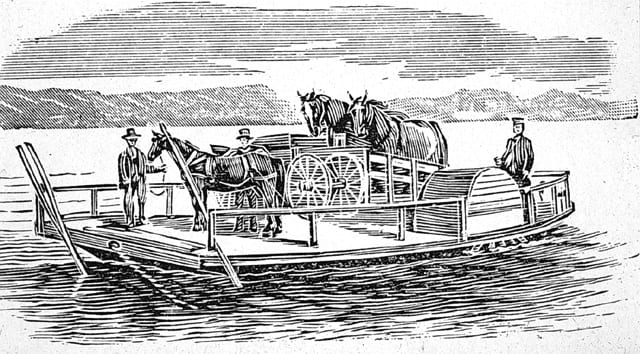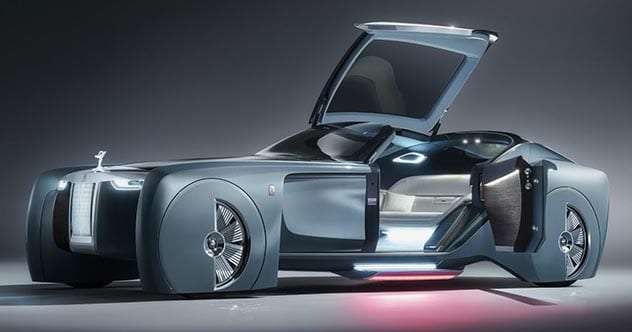 Mysteries
Mysteries  Mysteries
Mysteries  History
History 10 Surprising Stories About the Texas Rangers
 Humans
Humans 10 Philosophers Who Were Driven Mad by Their Own Theories
 Miscellaneous
Miscellaneous 10 Video-Game-Worthy Weapons and Armors from History
 Weird Stuff
Weird Stuff 10 Psychics Who Accurately Predicted Wartime Events
 The Arts
The Arts 10 Pieces of Art Inspired by a Broken Heart
 Health
Health 10 Science Fiction-Sounding New Medical Treatments
 History
History 10 Surprising Facts About the Father of Submarine Warfare
 Space
Space Ten Astonishing New Insights into Alien Worlds
 Weird Stuff
Weird Stuff 10 Bizarre Summer Solstice Rituals Still Practiced Today
 Mysteries
Mysteries Top 10 Haunting Facts About the Ghost Ship MV Alta
 History
History 10 Surprising Stories About the Texas Rangers
 Humans
Humans 10 Philosophers Who Were Driven Mad by Their Own Theories
Who's Behind Listverse?

Jamie Frater
Head Editor
Jamie founded Listverse due to an insatiable desire to share fascinating, obscure, and bizarre facts. He has been a guest speaker on numerous national radio and television stations and is a five time published author.
More About Us Miscellaneous
Miscellaneous 10 Video-Game-Worthy Weapons and Armors from History
 Weird Stuff
Weird Stuff 10 Psychics Who Accurately Predicted Wartime Events
 The Arts
The Arts 10 Pieces of Art Inspired by a Broken Heart
 Health
Health 10 Science Fiction-Sounding New Medical Treatments
 History
History 10 Surprising Facts About the Father of Submarine Warfare
 Space
Space Ten Astonishing New Insights into Alien Worlds
 Weird Stuff
Weird Stuff 10 Bizarre Summer Solstice Rituals Still Practiced Today
Top 10 Bizarre Modes Of Transportation
Everybody has to have a way to get from point A to point B. For most of us, it is the tried-and-true car. We can program our own radio stations, set the exact temperature, roll the windows up or down as we please, and even turn it into a garbage can on wheels. Alternatively, we might use a motorcycle, bicycle, skateboard, scooter, or our own two feet. There are also public transportation options like the bus, the trolley, and the subway; most big cities have at least one of those. Over the years, many countries have come up with their own unique ways for people to get around.
SEE ALSO: 10 Futuristic Forms Of Transportation We Could See Soon
10 Canada – The Horse Ferry

Whether in a small country like France, or a large one like China, there are usually bodies of water which require traversing. Canada is no different. Around the middle of the 19th century, they developed the horse ferry to take people and supplies across their lakes. Anywhere from two to five horses walked on a type of treadmill that was attached to paddlewheels. The boat moved due to the turning of the wheels. Horses get tired, and with only a max of five, these ferries could not go very fast nor very far. If you had wanted to get across say, Lake Manitoba, and were not pressed for time, the horse ferry was the way to go. Eventually though, the steam ferry became the faster, more sensible way to cross the waters of Canada.[1]
9 Cambodia – Bamboo Train (Norry)

The French first built railroad lines in Cambodia in the 1920s. Trains were quite popular for the next few decades until the French rule ended in 1953. Instability followed until the brutal Khmer Rouge regime began in 1975. By the time it ended a mere four years later, 20% of the population (1.4 million people) had died either from execution, starvation, or overwork. Over the next decade, the railroad areas were mined and trains frequently ambushed by remaining elements of the Khmer Rouge. Train operation slowed to a trickle; people needed an alternative.
With almost 400 miles of mostly unused track, industrious Cambodians developed the norry, affectionately known as the bamboo train. A norry has a tiny motor which sits on top of a bamboo platform about the size of a bed. Two independent sets of metal wheels are underneath with gravity holding it all together. Old tank parts, motors taken out of motorcycles, and rice harvesters provide the rest of the materials. Using a lever, the driver slides the motor backward, creating tension in a rubber belt that rotates the rear axle.
Locals might spend 50 cents for a ride, tourists ten times that. The bamboo train does not travel very fast; riders are able to get a great view of the Cambodian countryside. Transferring between different norries is common just to make a ten mile trip. Some of them were built to carry a few passengers; others hold thirty or more. These days, you might find it hard to find a ride on a norry. In the past decade, the Cambodian train system experienced a rebirth. The southern line opened commercially in 2010, and began carrying passengers in 2016. Just last year, a northern line opened up to the public.[2]
8 Portugal – The Monte Toboggan Sledge

During the 19th century, on Portugal’s Madeira Island, locals in the village of Monte wanted a faster route to get to the city of Funchal. Today, it is still a quick way to travel, but it has also become a highlight among tourists.
Made of eucalyptus wood and wicker, the frame is placed on wooden slats greased with tallow to allow sliding on the roads. The operators are known as Carreiros do Monte. There are about 150 of them, and they are all assigned particular driver numbers, which are passed onto apprentices upon retirement. Clad in white trousers and shirts, and a straw hat, they drive the sledge in pairs. Special boots are worn to aid in slowing down. Remember when you were a kid and you “found” a shopping cart to push each other down hills? The toboggan sledge ride sounds a little like that, only far safer.
The journey starts at the Church of the Lady Monte and travels down to the Estrada of the Livramento. With speeds up to over 20 miles per hour, the approximately 10-minute ride offers a one-of-a-kind trip throughout the city.[3]
7 Cuba – Cocotaxi

Cuba’s Cocotaxi resembles a giant yellow helmet with seats and wheels. It would not be too far off to compare them to a huge Pac-Man with people inside. They get their name, however, from a resemblance to the coconut. The actual components are plastic and fiberglass with two seats connected to a moped. A 75cc two-stroke engine is quite noisy, but more affordable than the traditional taxi. They are very popular amongst tourists. Just make sure you do not get ripped off by the driver.[4]
6 Netherlands – The Amfibus

An interesting way to get around The Netherlands came and went in about a year’s time back in 2011. Happily, the amphibian bus or amfibus came roaring back this past year. The tour starts in Amsterdam by road, and then continues via water on the IJ River. It lasts about an hour, with half spent on the water. The amfibus is manufactured by DAT (Dutch Amphibious Transport). DAT also makes the amphicruiser for when you just feel like driving your SUV into the water![5]
5 Philippines – The Jeepney

The Jeepney, a large, colorfully painted passenger truck resembling a Jeep, has been a part the daily lives of most people in the Philippines for nearly 80 years. The original jeepneys were made out of Jeep parts left behind by American troops after World War II. After the war, the Philippines government did not create a mass transport system, so jeepneys became the most popular mode of transport.
Jeepneys operate sort of like buses. They have designated routes, but no designated stops. They are blamed for traffic problems because they stop so often to accommodate passengers. Unlike most buses we are used to, the Jeepney is typically splashed with bright colors and ornaments. Often, the driver will pick a name or phrase and have it painted somewhere on the vehicle.
The big problem with the Jeepney, however, has been its high pollution levels. They are responsible for 15 percent of particulate matter in Metro Manila. Much to the chagrin of the general public, President Rodrigo Duterte ordered all Jeepneys older than fifteen years to be taken off the road by 2020 and replaced with more eco-friendly versions. Gone soon will be the sight of Jeepneys decorated with disco lights, superheroes, chrome wheels, and other adornments. Also disappearing are the jobs for painters of the Jeepney. “This is an act of treachery against fellow Filipinos,” said artist Bernardo de la Cruz. “This is a uniquely Filipino product. We were born with it.”[6]
4 Thailand – Tuk Tuk

Similar to the jeepney, the tuk tuk (also known as the auto-rickshaw) was developed after World War II to combat the lack of transportation. It originated in Italy, designed by Corradino D’ascanio, the same person who built the Vespa scooter. Today, the tuk tuk can be found on just about every continent, but is most common in Africa and Asia.
In Thailand, the tuk tuk owes its roots to the Japanese who popularized it during their occupation of the region during WWII. The older ones in Thailand used a 350cc two-stroke engine leading to the “tuk tuk” sound as they motor around the streets. Today, they are outfitted with a 660cc four-stroke engine, making them much quieter. The Thai tuk tuk, with its blue and yellow color scheme, has become a sort of a global symbol of the country. As with a lot of the vehicles on our list, tourists flock to Thailand’s preferred mode of transport. They are not allowed on certain roads like freeways, so you will not be catching one to or from the airport. Yet tourists still cannot get enough of the classic tuk tuk.[7]
3 New Zealand – Shotover Jet
 New Zealand’s Shotover Canyons provide the backdrop to one of the more exciting ways to get around in Oceania. The Shotover Jets are built in Queenstown specifically for the tours of the canyons on the Shotover River. With twin V8 engines and 700 total horsepower, the boat can get over 55 miles an hour. Water drawn into intakes on the bottom is propelled and driven through rear nozzles to propel the boat forward. Turning the nozzles steers the boat.
New Zealand’s Shotover Canyons provide the backdrop to one of the more exciting ways to get around in Oceania. The Shotover Jets are built in Queenstown specifically for the tours of the canyons on the Shotover River. With twin V8 engines and 700 total horsepower, the boat can get over 55 miles an hour. Water drawn into intakes on the bottom is propelled and driven through rear nozzles to propel the boat forward. Turning the nozzles steers the boat.
Shotover Jet Services opened in 1965 as a sightseeing company for close to a decade. In the early 1970s they upgraded their boats and pivoted to providing an adventure ride. Since 1987 they have been the only company to operate in the canyons. Each of the seven boats can carry a maximum of fourteen passengers, with over 100,000 passengers a year catching a ride through the canyons.[8]
2 Kenya – Matatu

The matatu is reminiscent of a party bus. Graffiti-style artwork adorns the outside, loud music roars on the inside. By 1928, the capital city of Nairobi had the highest per capita private car ownership in the world. However, there was no public transportation system. The Kenyan Bus Services was later created. By the 1950s, it needed to expand and the matatu was born.
The matatu is the preferred method of transportation in Kenya not just because of the look, but because they are cheap and convenient. In the capital city of Nairobi, the matatus are ubiquitous. Each one is decorated with different images like those of pop stars, athletes, and even religious symbols. Local musicians receive promotion from the matatus’ blasting their songs up and down the streets.
A lot of care and money goes into the creation of each minibus. Some even sport onboard WiFi, and TVs. Matatus are built from the ground up, typically by using the stripped chassis of a new truck. Panels are attached, and the artists come in to paint the outside. In the middle of last decade, the government banned matatu art and loud music for safety reasons. The ban was lifted in 2015. Another ban was attempted in late 2018, but lifted the next day after public outcry. It would seem that the symbiotic nature between the matatu and the Kenyan people is too tight a bond to break.[9]
1 United Kingdom – Rolls Royce 103EX

The Rolls Royce 103EX concept car, also called the Vision Next 100, is a luxury behemoth the company trots out to tout the future of automobile making. The interior sports a silk lounge chair, actual wood, and handwoven wool carpet. To get inside, the door opens after the roof swings upward, allowing people to stand totally upright. The wheel wells make the car look like it is almost hovering above the ground. It also includes a virtual assistant/chauffeur known as Eleanor.
Rolls Royce Motor Cars Limited is promising that the next 100 years of car production will be all about the driver and their choices. Their website states that “each Rolls-Royce will be designed less like a car, and more like an individual sculpture made from one seamless surface.” Sadly, the Rolls Royce 103EX will never see production. However, it does promise intriguing things for not only the future of the automobile, but possibly a radical change to transportation in general.[10]
For more offbeat lists like this take a look at Top 10 Countries With Bizarre Obsessions, and 10 Bizarre Origin Stories About Your Favorite Foods.
About The Author: Hello everyone on the internet! A little about me: I have two degrees in film: my B.A. from UC Berkeley, and my M.F.A. from Academy of Art University. I worked for a little while in the production office on several films including Bee Season, and Milk. I transitioned to TV and spent a few years in the “bullpen” working on live games for Pac-12 Networks. Lately, I’ve found that writing is what really does it for me. I’ve been writing film reviews for almost five years for the Concord/Clayton Pioneer. Very recently I’ve decided to branch out into comic books and online writing. I have also been a swim coach for twenty years.








